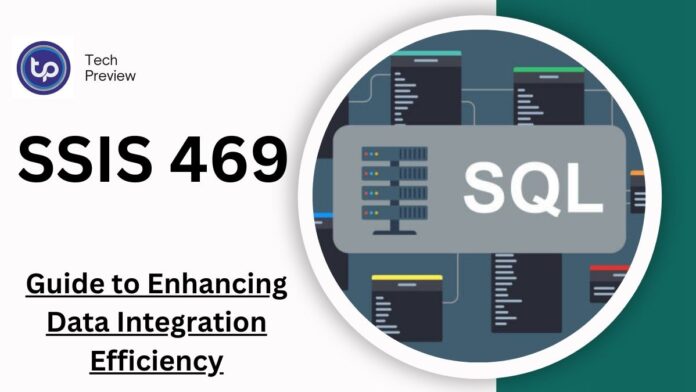Data integration is crucial for businesses that aim to achieve seamless operations, improved decision-making, and optimal workflow efficiency.
SQL Server Integration Services (SSIS) 469, a powerful ETL (Extract, Transform, Load) tool provided by Microsoft, allows businesses to streamline their data workflows and enhance organizational efficiency.
SSIS 469 has features designed to handle complex data tasks while ensuring high performance and scalability.
What is SSIS 469?
SSIS 469 is an advanced data integration tool, part of Microsoft’s SQL Server suite, designed to automate the process of extracting, transforming, and loading data from various sources.
Its user-friendly, visual development environment allows organizations to build efficient data workflows, ensuring that critical data is handled and processed quickly and accurately.
Key Features of SSIS 469
SSIS 469 distinguishes itself from other ETL tools by offering flexible, high-performance capabilities that are essential in modern data environments.
| Feature | Description |
|---|---|
| Visual Development Interface | Allows users to design ETL workflows via drag-and-drop, enabling faster development and deployment. |
| High Scalability | SSIS 469 scales horizontally across multiple servers, ensuring efficient data processing even in large-scale environments. |
| Robust Connectivity | Supports diverse data sources including SQL Server, Oracle, MySQL, flat files, and cloud services like Azure. |
| Data Transformation Flexibility | Offers built-in transformations for data cleansing, aggregation, merging, and conditional splitting to ensure accurate data integration. |
| Real-time Data Processing | Capable of handling real-time data, enabling businesses to make timely decisions based on up-to-date information. |
| Monitoring and Logging Tools | Provides detailed execution logs and a dashboard for visual insights into package execution and performance. |
MUST HAVE: SSIS 858: A Complete Guide to Streamlining Data Integration
Why SSIS 469 is Crucial for Data Integration
Data integration can often become a bottleneck in business operations, especially as organizations grow and data systems become more complex. SSIS 469 addresses these challenges by simplifying the data integration process while ensuring high scalability and performance.
- Simplified ETL Processes: With its visual interface, SSIS 469 makes it easier to design, manage, and deploy ETL processes, reducing development time.
- Real-time Processing Capabilities: For organizations dealing with real-time data, SSIS 469 provides the ability to process and act on data insights instantly.
- Improved Data Quality: The built-in transformations and error-handling mechanisms ensure that data is clean, accurate, and ready for business analysis.
Use Cases for SSIS 469
SSIS 469 has found its way into various industries, serving a wide range of data integration needs. From data warehousing to real-time processing, here are a few key use cases:
- Data Warehousing: SSIS 469 automates the ETL process for data warehouses, allowing for large-scale extraction, transformation, and loading of data into central repositories. This supports advanced reporting and analytics functions.
- Data Migration: When moving data between systems, SSIS 469 ensures the smooth migration of large datasets while maintaining data integrity. This is especially useful during system upgrades or transitions to cloud-based environments.
- Real-time Data Processing: For industries requiring real-time data analysis, such as finance or retail, SSIS 469 handles streaming data from various sources, providing timely insights for decision-making.
How to Get Started with SSIS 469
Installation and Setup
Setting up SSIS 469 is simple. The software can be downloaded directly from Microsoft’s SQL Server suite, and the installation wizard guides users through configuration steps.
Once installed, the user can establish connections to various data sources and configure them for integration.
Designing ETL Workflows
SSIS 469’s drag-and-drop interface allows users to build complex ETL workflows easily. Start by setting up data flows between sources and destinations, incorporating transformation components such as data cleansing, sorting, and filtering to ensure optimal results.
Monitoring and Performance Tuning
SSIS 469 provides robust monitoring and logging capabilities to ensure that your workflows are performing optimally. The SSISDB catalogue stores packages and logs execution data, while the Integration Services Dashboard offers visual insights into the performance of your ETL jobs.
Challenges and Best Practices for SSIS 469
While SSIS 469 offers a wide range of benefits, there are certain challenges that organizations should be aware of when using the platform:
- Complex Package Development: Managing multiple packages and components can become complicated for large-scale projects. Breaking ETL processes into modular, reusable packages can help manage this complexity.
- Performance Bottlenecks: In high-demand environments, performance issues may arise if SSIS 469 is not properly configured. Fine-tuning the data flow, using appropriate data types, and optimizing resource allocation can help improve performance.
- Compatibility with Legacy Systems: Organizations may face compatibility issues when integrating with older systems. Ensuring thorough compatibility testing is essential to a smooth integration process.
Best Practices:
- Design Modular Packages: Break complex workflows into smaller, reusable packages to enhance scalability and maintenance.
- Error Handling and Logging: Implement robust error handling and detailed logging to ensure that any issues during the ETL process are easily identifiable and resolved.
- Performance Optimization: Regularly monitor your workflows and tweak performance like optimizing data flows, using appropriate indexing, and balancing workloads across servers.
Future Trends in SSIS 469 Development
As technology continues to evolve, SSIS 469 is poised to incorporate several trends that will further enhance its utility and performance:
- Cloud Integration: With more organizations adopting cloud-based systems, SSIS 469 will continue to integrate with platforms like Azure, making hybrid and multi-cloud strategies easier to manage.
- Containerization: Expect to see more development around containerized environments, allowing SSIS 469 to run efficiently in isolated, scalable units.
- Machine Learning Integration: The future of SSIS 469 may involve deeper integration with AI and machine learning platforms, helping businesses automate and optimize data transformations based on advanced predictive models.
Conclusion
SSIS 469 is a valuable tool for organizations looking to streamline their data integration processes. With its scalable architecture, robust connectivity options, and flexible ETL capabilities, SSIS 469 stands out as an essential tool for modern enterprises.
By following best practices and staying informed about future trends, businesses can leverage SSIS 469 to drive efficiency, improve data quality, and enhance decision-making.








